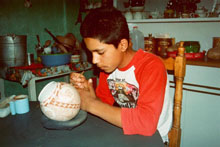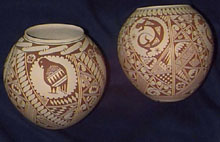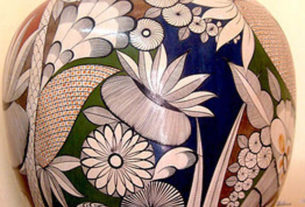Juan Mata Ortíz is a small village of potters, farmers and cowboys in Northern Chihuahua. About 30 years ago, an unschooled artistic genius, Juan Quezada, taught himself how to make earthenware jars in a method used hundreds of years ago by the prehistoric inhabitants. Now, his works are known worldwide and over 300 men, women and children in the village of less than 2000 make decorative wares. Much of the polychrome and blackware is feather light and exquisitely painted.
Many of the potters are also cowboys and farmers. These stories serve to document the art and the people in this unassuming pueblo, which is often called “magical” by the relative handful of tourists who visit. Enjoy this other view of Mexico.
Ramirín Velóz grew up in a pottery family. His father, Ramiro, made the earthenware bowls and his mother, Sylvia, painted the crème-colored pieces with classic red ” Casas Grandes” designs. The parents, Ramirín (“Little Ramiro”), and his two sisters lived in an old high-ceiling adobe structure on the front street facing the train station in Mata Ortíz. The home is more spacious than many in the village. He often played in his wide “backyard” where Sylvia would proudly show off the six-foot high by six-foot wide century plant that indeed looked to be 100 years old.
The five or six pots made each month generated the sole income for the family. They weren’t rich, but the husband/wife team made ends meet – and they were a close family. Ramiro and his brother Saul had begun making pottery in the 1980’s, after watching their neighbors, the Quezadas reaping benefits from the ceramic sales. Unlike most potters in Mata Ortíz, the brothers didn’t use the coil method to build tall ollas. Instead, they would lay a tortilla of clay in their six-inch wide plaster of Paris molds and pinch and pull the plastic clay upwards to create paper-thin jars standing about eight inches high.
Ramiro soon found that he was a good potter, but a poor painter. Sylvia, however, was magic with the brush. First, she would lay the design on the rounded clay “canvas” with a brush displaying a mere three bristles, plucked from her young son’s or daughter’s head. Then she would fill in the forms with a commercial paintbrush – the kind kids might use in an elementary school art class.
The pottery was quickly in demand by both traders and tourists alike.
 When Ramirín was 11, he made and painted his first olla. Like most children in the village, he had passed many hours watching his parents work in their kitchen-father making, mother painting. The same table employed for creating pottery was used for dining. After school, on cold winter afternoons, he would sit at the table, hands on chin, taking it all in.
When Ramirín was 11, he made and painted his first olla. Like most children in the village, he had passed many hours watching his parents work in their kitchen-father making, mother painting. The same table employed for creating pottery was used for dining. After school, on cold winter afternoons, he would sit at the table, hands on chin, taking it all in.
That first pot was feather light. Not as delicate as his father’s, but thinner than those of many of the other, more experienced potters – thanks to only employing the pinch-and-pull method. The painting was what one would expect of an 11-year old. There were childish designs and occasionally wavering lines. But it was obvious that a new talent was germinating, waiting to sprout. When I bought that jar for $5.00, Ramirín’s Bambi-brown eyes glowed with pride and pleasure. His parent’s beamed. Another potter was born.
Six months later, the boy’s mother was dead.
Sylvia developed a cancerous tumor at the base of her spine. She went to a hospital in Chihuahua City where she was bed-ridden for over three months in a crowded public ward. The cancer metastasized and spread to her brain. Finally, the doctors said there was nothing they could do for the poor woman and they recommended that she be returned home where she could at least pass her final days in the comfort of family and friends.
Her husband and brother borrowed a pickup truck for the trip and drove to Chihuahua City. They placed Sylvia on a mattress in the truck bed and covered her with blankets. The first four hours of the journey passed quickly and the once vibrant woman suffered little, sleeping most of the time. The last twelve miles from the Mormon community of Colónia Juárez to Mata Ortíz was over a pot-holed, washboard of a hardpan road. It was a 12-hour ordeal.
“We had to keep stopping,” Ramiro said. “She was awake and every lurch, every bump caused her great pain.”
Sylvia Velóz de la Casas was placed on a bed in the living room of her sister Guadalupe’s house. Made as comfortable as possible, she fell into a coma. Surrounded by family and relatives, she died in the middle of the night without regaining full consciousness. Ramirín and his sisters never really had a chance to say goodbye to their mother.
 Without his wife, Ramiro was now faced with completing the whole pottery process alone: making, painting and firing. He tried, but while the ceramics were still as thin as ever, the designs were crudely rendered. He didn’t even want to sell them. Desperate, he prevailed upon his brother, a more talented painter than potter, to help him. For a while, Saul did apply the decoration, but the pressure was too much. After all, he had his own pottery to make to support his family. He and his wife had two beautiful daughters and a new baby was on the way.
Without his wife, Ramiro was now faced with completing the whole pottery process alone: making, painting and firing. He tried, but while the ceramics were still as thin as ever, the designs were crudely rendered. He didn’t even want to sell them. Desperate, he prevailed upon his brother, a more talented painter than potter, to help him. For a while, Saul did apply the decoration, but the pressure was too much. After all, he had his own pottery to make to support his family. He and his wife had two beautiful daughters and a new baby was on the way.
Up until the time of his mother’s death, the young boy, now 12 and in the Fifth Grade, had been making and painting pottery, both bowls and little plates. Ramirín’s talent had been improving slowly, but not spectacularly. After Sylvia died, he stopped working, except to help his father fire the completed ceramics. One day, after coming home from school, he approached his father.
“Papí,” Ramirín said. “I will paint the pots.”
Now, in our culture, the response would be “Oh, you’re too young, you need to get more experience.” But Ramiro’s answer was, “OK, give it a try.”
What happened next was miraculous. Some might say the result was a gift from Heaven. The youngster sat at the table where he had learned to paint while watching his mother work. Taking a brush and one of his father’s greenware, he began applying the designs in the manner of his mamí, Sylvia. It was as though she placed her hand invisibly over his own and guided him through the complex and delicate procedure. When finished and fired, it appeared his mother had painted the olla.
The trader who bought as much pottery he could from the family said, “I couldn’t tell that his mother hadn’t painted it. The quality was equal to hers.”
Today, five years later, Ramirín has changed his name to Ramiro Jr., as befits a teen on the cusp of adulthood. He and his father are now the team. They live in the same house and they support themselves and the two other children. The traders and tourists still come and they buy everything-and the ceramics still look like Sylvia has painted them.

